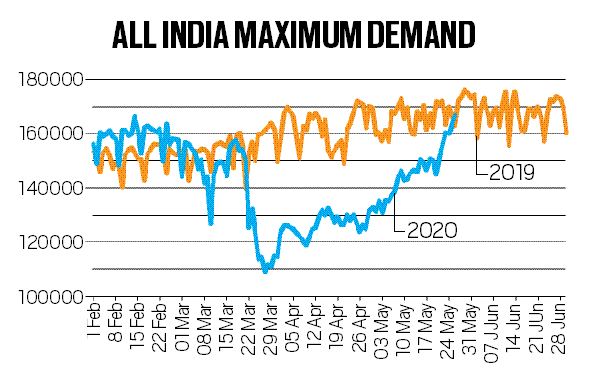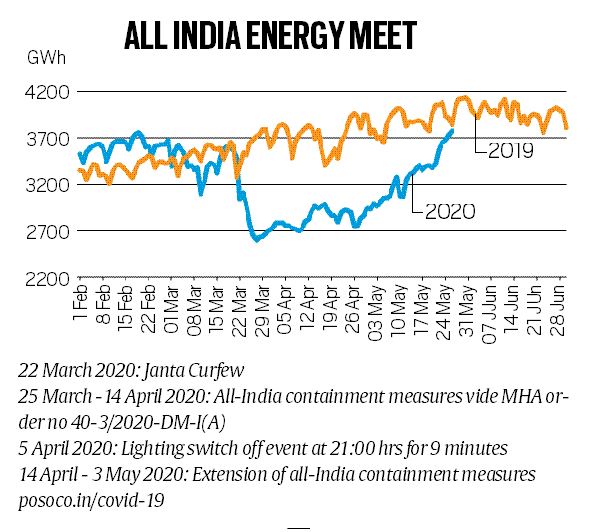- India
- International
Heat wave, restart of industrial activity push power demand close to last year’s levels
Tuesday's peak demand figure — the highest power demand met during the day — actually crossed the level of last year, the first time this has happened since March 22.
 Evidence of the rising industrial load is reflected on the Indian Energy Exchange, India’s largest power exchange, which recorded its highest volume of 211 million units (MUs) in the current fiscal on May 25. (File Photo)
Evidence of the rising industrial load is reflected on the Indian Energy Exchange, India’s largest power exchange, which recorded its highest volume of 211 million units (MUs) in the current fiscal on May 25. (File Photo)
A steady recovery in electricity demand, which picked up pace after May 10, offers the first definitive indicator of the gradual return to normalcy following the extended lockdown.
After a sudden plunge nine weeks ago, electricity demand is now within touching distance of the corresponding figures for last year.
In fact, Tuesday’s peak demand figure — the highest power demand met during the day — actually crossed the level of last year, the first time this has happened since March 22.
The more-relevant ‘energy met’ figure for May 26 —an indicator of overall electricity consumption — was marginally short of the figure clocked on the same day last year, according to the latest data compiled by state-owned grid manager Power System Operation Corporation (POSOCO) Ltd.
Explained: Why the present heatwave in North India is unusual

While the sudden intensification of the summer heat in North India is partly responsible for the pick-up in domestic load, the gradual resumption of operations across the country’s industrial pockets, alongside the resumption of rail and other transportation services, is pushing up demand.
The restarting of industrial activity, evidenced mainly by the larger companies resuming partial operations and this having a catalysing impact on the smaller vendor ecosystems, is slowly adding to the industrial load, which is now complementing the surge in the summer-powered domestic load.


Evidence of the rising industrial load is reflected on the Indian Energy Exchange, India’s largest power exchange, which recorded its highest volume of 211 million units (MUs) in the current fiscal on May 25.
The resumption of activity in major manufacturing sector units is visible across geographies. While the energy met figures for May 26 at over 3,775 gigawatt hours (GwH) was a shade less than the 3,850GwH on the same day the previous year, experts said that the figure for this year needed to cross last year’s number and go beyond to indicate a return to the normal trendline – given that the demand figure was around 5 per cent higher since the beginning of the year, and until the lockdown announcement came in late March.
“There is a slow and steady increase in demand in all five regions from April 27, during the closing period of phase 1 of the lockdown. From May 4-12, there is a slow increase with the effect of weather fluctuations clearly visible on the electricity demand pattern,” an official involved with the Central Electricity Authority (CEA), which collates the data, said.
“The demand is yet to catch up with last year. Normally, demand in a year is 5-6% higher corresponding to the same period last year. From May 10 onwards there seems to be a more decisive increase in demand in all the five regions, but we will have to wait and watch to ascertain the trend,” the official said.
Ever since the lockdown was imposed in mid-March, the grid load has been primarily on account of domestic load. The normal base load power demand of roughly 150 gigawatts had dropped by over 20 per cent after the lockdown. Domestic load is about 30-32 per cent of total load during normal times. Of India’s total electricity demand load pattern, industrial and agricultural consumption accounts for 40 per cent and 20 per cent load respectively, while commercial electricity consumption accounts for 8 per cent of demand.
Apr 23: Latest News
- 01
- 02
- 03
- 04
- 05






































